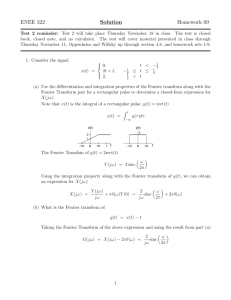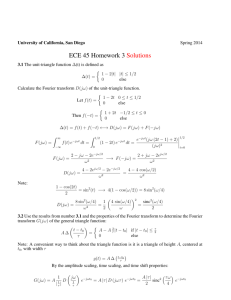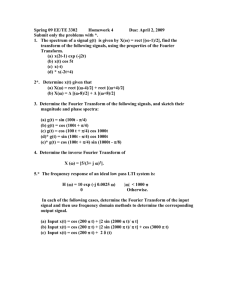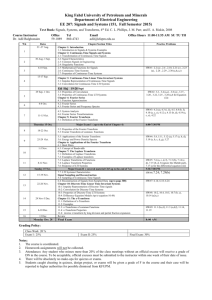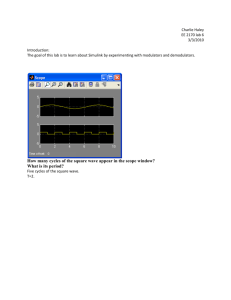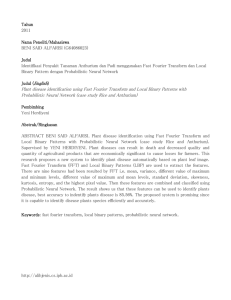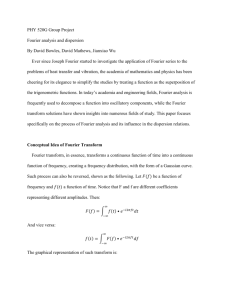Homework 6 SOLUTION EE235, Summer 2013 Due August 13th in
advertisement
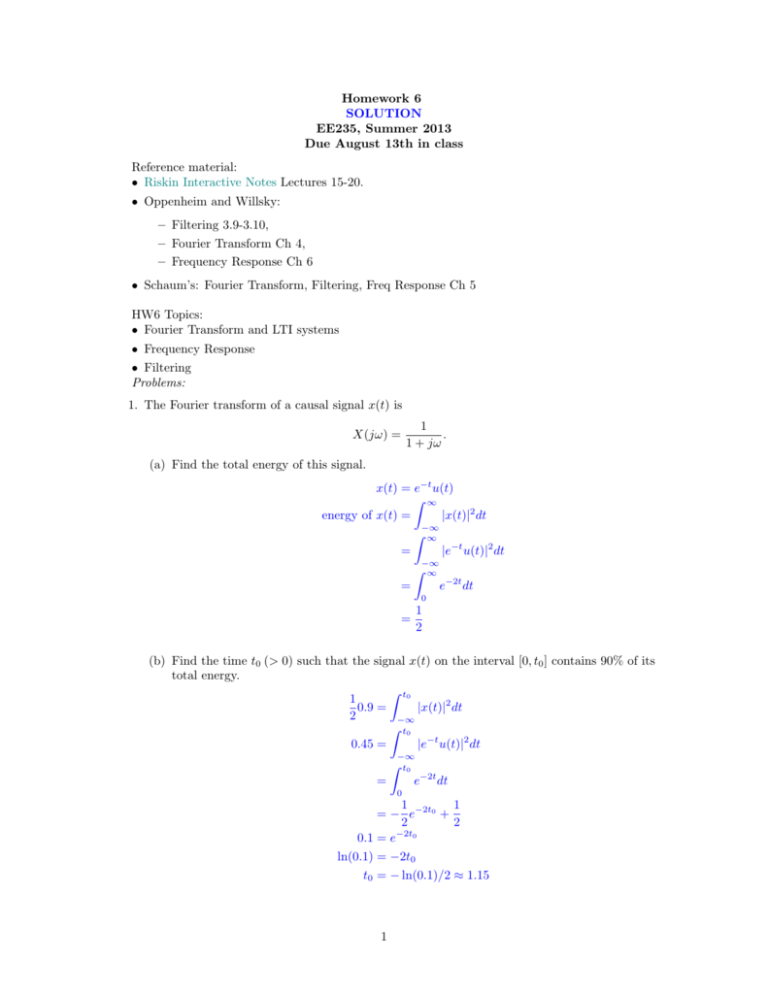
Homework 6
SOLUTION
EE235, Summer 2013
Due August 13th in class
Reference material:
• Riskin Interactive Notes Lectures 15-20.
• Oppenheim and Willsky:
– Filtering 3.9-3.10,
– Fourier Transform Ch 4,
– Frequency Response Ch 6
• Schaum’s: Fourier Transform, Filtering, Freq Response Ch 5
HW6 Topics:
• Fourier Transform and LTI systems
• Frequency Response
• Filtering
Problems:
1. The Fourier transform of a causal signal x(t) is
1
.
1 + jω
X(jω) =
(a) Find the total energy of this signal.
x(t) = e−t u(t)
Z ∞
energy of x(t) =
|x(t)|2 dt
−∞
Z ∞
=
|e−t u(t)|2 dt
−∞
Z ∞
=
e−2t dt
0
1
=
2
(b) Find the time t0 (> 0) such that the signal x(t) on the interval [0, t0 ] contains 90% of its
total energy.
Z t0
1
0.9 =
|x(t)|2 dt
2
−∞
Z t0
0.45 =
|e−t u(t)|2 dt
−∞
t0
Z
=
e−2t dt
0
1
1
= − e−2t0 +
2
2
0.1 = e−2t0
ln(0.1) = −2t0
t0 = − ln(0.1)/2 ≈ 1.15
1
(c) Find the frequency ω0 (> 0) such that the signal x(t) within the frequency band [−ω0 , ω0 ]
contains 90% of its total energy.
Hint: Use Parseval’s Theorem
By Parseval’s theorem,
Z
Z ∞
1
|X(w)|2 dw
2π −∞
−∞
1
energy of x(t) =
energy of X(w)
2π
∞
|x(t)|2 dt =
so the energy of X(w) is π.
Z
w0
|X(w)|2 dw
0.9π =
−w0
w0
Z
1
|2 dw
1 + jw
1
dw
1 + w2
|
=
−w0
w0
Z
=
−w0
0
= tan−1 (w)|w
−w0
= tan−1 (w0 ) − tan−1 (−w0 )
since tan−1 (z) is an odd function
0.9π = 2 tan−1 (w0 )
0.9π
w0 = tan(
) ≈ 6.31 rad/s
2
x(t)
2
1
t
−1
1
2
3
Figure 1: x(t) for problem 2
2. More Fourier transform properties. Let X(jω) denote the Fourier transform of the signal x(t)
shown in figure 1.
(a) Find X(0).
Z
∞
x(t)e−jwt dt
Z ∞
X(0) = X(w) w=0 =
x(t)dt
X(w) =
−∞
−∞
So X(0) is the area under x(t)
X(0) = 7
2
(b) Find
R∞
−∞
X(jω)dω.
1
2π
∞
Z
X(w)ejwt dw
−∞
Z ∞
1
X(w)dw
x(0) = x(t)|t=0 =
2π −∞
x(t) =
Z
∞
X(w)dw = 2πx(0) = 4π
−∞
(c) Evaluate
R∞
−∞
|X(jω)|2 dω. By Parseval’s theorem,
Z
∞
1
2π
|x(t)|2 dt =
−∞
so, this integral is
Z ∞
Z
2
|X(w)| dw = 2π
−∞
Z
∞
|X(w)|2 dw
−∞
∞
|x(t)|2 dt
−∞
Z 0
= 2π[
Z
4dt +
−1
1
0
Z
1
Z
2
(t − 4t + 4)dt +
= 2π[4 +
0
3
2
Z
(2 − t)2 dt +
(t)2 dt +
Z
3
4dt]
1
2
2
(t)2 dt + 4]
1
t3
t
− 2t2 + 4t)|1t=0 + ( )|2t=1 + 4]
3
3
8 1
1
= 2π[4 + ( − 2 + 4) + ( − ) + 4]
3
3 3
2
38
76π
= 2π[12 + ] = 2π[ ] =
3
3
3
= 2π[4 + (
Note: You should perform all these calculations without explicitly evaluating X(jω).
3. An LTI system has an impulse response given by
h(t) = δ(t) −
5
sinc(5t).
π
H(ω) = 1 − rect(ω/10).
(a) Classify the above filter as lowpass/highpass/bandpass/bandstop/allpass. (It may help
to draw the Fourier transform.)
Highpass
H(ω)
1
ω
−8
−6
−4
−2
3
2
4
6
8
(b) Find the output y(t) corresponding to the input x(t) = sin(3t).
The Fourier transform of the input is X(s) = πj [δ(w −3)−δ(w +3)], which is two impulses
at w = 3 and w = −3. Since the cutoff of the highpass filter is wc = 5, these impulses
get filtered out, so y(t) = 0.
Mathematically,
Y (w) = X(w)H(w)
π
= [δ(w − 3) − δ(w + 3)][1 − rect(ω/10)]
j
π
= [δ(w − 3) − δ(w + 3) − δ(w − 3) + δ(w + 3)]
j
F−1
= 0 −→ y(t) = 0
(c) Find the output y(t) corresponding to the input
x(t) = cos(2t) + sin(8t).
The Fourier transform of the input is
X(ω) = πδ(ω − 2) + πδ(ω + 2) + jπδ(ω − 8) − jπδ(ω + 8)
The deltas at ±2 are filtered out (they become zero), so the output is.
y(t) = sin(8t).
4. Write these filters by using rect(ω/2B) functions.
(a) Write an ideal bandpass filter G(ω) that passes only frequencies 3 < |ω| < 7.
G(ω) = rect(
ω
ω
) − rect( )
14
6
(b) Write an ideal bandreject filter H(ω) that rejects only frequencies 3 < |ω| < 7, and
passes all other frequencies.
H(ω) = 1 − G(ω) = 1 − rect(
ω
ω
) + rect( )
14
6
5. A causal LTI system is described by the following differential equation:
dy(t)
+ 5y(t) = 2x(t).
dt
(a) Find the frequency response H(ω) of this system
jωY (ω) + 5Y (ω) = 2X(ω)
(jω + 5)Y (ω) = 2X(ω)
H(ω) =
4
2
Y (ω)
=
X(ω)
5 + jω
(b) Find the magnitude of the frequency response, |H(ω)|.
2
5 + jω
H(ω) =
2
=√
ω 2 etan−1 (−ω/5)
25 +
−1
2
=√
e− tan (−ω/5)
2
25 + ω
| {z }
|H(ω)|
p
H(ω)H ∗ (ω)
p
|H(ω)| = H(ω)H ∗ (ω)
r
2
2
=
·
5 + jω 5 − jω
2
=√
25 + ω 2
Or by using the formula |H(ω)| =
(c) Sketch the magnitude of the frequency response (for both positive and negative ω).
|H(ω)|
2
1
6 5 4 3 2 1 0 1 2 3 4 5 6ω
(d) Classify this system as lowpass/highpass/bandpass/bandstop/allpass.
Lowpass
(e) Find the impulse response h(t) of this system.
h(t) = 2e−5t u(t)
(f) We build another LTI system by making its impulse response
h1 (t) = h(t) cos(50t).
Classify this system as lowpass/highpass/bandpass/bandstop/allpass. Justify your answer by giving the approximate frequency range which the filter passes. (It may be useful
to try to sketch |H1 (ω)|.)
H1 (w) =
1
[H(w − 50) + H(w + 50)]
2
|H1 (ω)|
2
1
50 ω
50
Bandpass; It passes frequencies around 50 rad/s (approximately 48 rad/s to 52 rad/s).
6. Consider an LTI system with impulse response
h(t) = e−4|t| .
5
(a) Show the frequency response of this LTI system.
Z 0
Z
4t −jωt
H(ω) =
e e
dt +
−∞
Z
0
e
(4−jω)t
e(−4−jω)t dt =
dt +
−∞
e−4t e−jωt dt
0
∞
Z
∞
0
1
1
8
−
= 2
4 − jω 4 + jω
ω + 16
(b) We have an input
x1 (t) =
+∞
X
δ(t − n).
n=−∞
Is the output a periodic signal? Justify your answer. If “yes,” find its Fouries series
coefficients. This is a periodic pulse train with period T=1. The following Fourier Series
pair can be applied:
∞
2kπ
2π X
)
δ(ω −
δ(t − nT ) =
T
T
n=−∞
n=−∞
∞
X
Therfore the output is:
∞
8 × 2π X
δ(ω − 2kπ)
ω 2 + 16 n=−∞
As a result, the Fourier Series Coefficients are (for integer values of k):
16π
δ(ω − 2k)
+ 16
ω2
(c) Repeat the same questions for another input
x2 (t) =
+∞
X
(−1)n δ(t − n).
n=−∞
The input is a series of alternating positive and negative deltas that can be rewritten as:
x2 (t) =
+∞
X
δ(t − 2n) −
n=−∞
X(ω) =
+∞
X
δ(t − (2n + 1))
n=−∞
∞
∞
2kπ
2π X
2kπ
2π X
δ(ω −
) − e−jω
δ(ω −
)
2 n=−∞
2
2 n=−∞
2
Therefore the fourier series coefficients are:
2πk
8π
δ
ω
−
(1 − e−jω )
ω 2 + 16
2
7. Let
sin t
.
πt
Assuming that x(t) is band-limited and X(jω) = 0 for |ω| ≥ 1, does there exist an LTI system
T {·} such that T {x(t)} = y(t)? Justify your answer. If “yes,” give the impulse response of
this LTI system. From trigonometric identities we have:
1 cos(2t)
sin(t)
y(t) = x(t) ×
+
∗
2
2
πt
y(t) = (x(t) cos2 t) ∗
6
Next we take the Fourier transform:
π
π
ω
1
δ(ω) + δ(ω − 2) + δ(ω + 2) × rect( )
Y (jω) = X(jω) ∗
2
2
2
2
1
ω
× {X(jω) + πX(j(ω − 2)) + πX(j(ω + 2))} × rect( )
2
2
ω
Since the signal is band-limited and rect( 2 ) function is zero for |ω| > 1 the X(j(ω + 2)) and
X(j(ω − 2)) terms disappear and we are left with:
Y (jω) =
1
X(jω)
2
Y (jω) =
Y (jω) = X(jω)H(jω)
H(jω) =
1
2
Taking the inverse Fourier transform yields:
h(t) =
1
δ(t)
2
8. From previous lectures we know that the energy of a complex signal x(t) is,
Z ∞
Wx =
|x(t)|2 dt
−∞
Noting that |x(t)|2 = x(t)x∗ (t) determine the relationship between finding the energy of a
signal in the time domain and finding the energy of the signal in the frequency domain. This
is an important relation called Parsivals Theorem. (Hint: determine what x∗ (t) is equal to in
the frequency domain as your first step)
Given X(ω) we can write x(t) and x∗ (t) as:
Z ∞
1
x(t) =
X(ω)ejωt dω
2π −∞
1
x (t) =
2π
∗
Z
∞
X ∗ (ω)e−jωt dω
−∞
Next, we can substitute into the following equation replacing one of the ω’s with α:
Z ∞
Z ∞
|x(t)|2 dt =
x(t)x∗ (t)dt
−∞
Z
∞
−∞
x(t)
−∞
1
2π
Z
∞
X ∗ (jω)e−jωt dω dt
−∞
Reordering:
1
2π
Z
∞
−∞
X ∗ (jω)
Z ∞
1
x(t)e−jωt dt dω =
X ∗ (jω)X(jω)dω
2π −∞
−∞
Z
∞
9. Use Parsivals Theorem to solve the following problem,
Z ∞
2
χ=
dω
|jω
+
2|2
−∞
7
e−2t u(t) ↔
1
jω + 2
Using Parseval’s Theorem:
Z
∞
−∞
2
dω =
|jω + 2|2
Z
4π
√ 2
Z ∞
2 |e−2t u(t)|2 dt
dω = 4π
jω
+
2
−∞
−∞
Z
∞
∞
e−4t dt = −
0
4π
(0 − 1) = π
4
BONUS LEARNING: If an image has some feature with a strong spatial frequency and you undersample the image spatially, then you can get an aliasing effect called moiré. Check out some
examples and more discussion of moiré at http://en.wikipedia.org/wiki/Moire.
8
